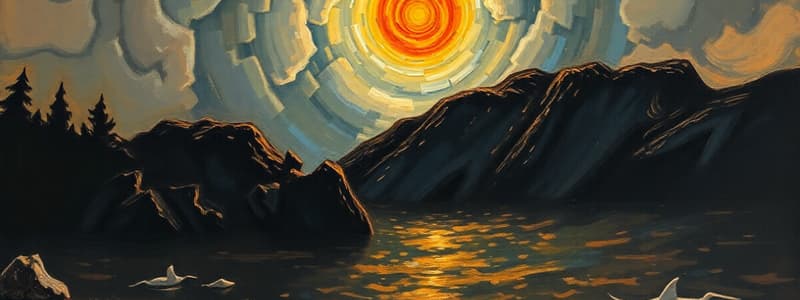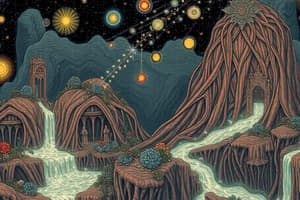Podcast
Questions and Answers
What differentiates an island from other landforms in the ocean?
What differentiates an island from other landforms in the ocean?
- It is part of the ocean basin extending from the ocean floor. (correct)
- It has no connection to the ocean floor.
- It is exclusively a volcanic formation.
- It is surrounded entirely by freshwater.
Which type of ocean basin is characterized by uplift?
Which type of ocean basin is characterized by uplift?
- Mature Ocean Basin
- Declining Ocean Basin
- Juvenile Ocean Basin
- Embryonic Ocean Basin (correct)
What is the main feature of a mid-oceanic ridge?
What is the main feature of a mid-oceanic ridge?
- It is a flat underwater surface devoid of geological activity.
- It is associated with the downwelling of magma.
- It is formed by the convergence of tectonic plates.
- It is the site of upwelling magma causing sea floor spreading. (correct)
In which stage of the Wilson Cycle does the ocean basin begin to close?
In which stage of the Wilson Cycle does the ocean basin begin to close?
Which oceanic feature is the deepest part of the ocean?
Which oceanic feature is the deepest part of the ocean?
What is the primordial heat of the Earth attributed to?
What is the primordial heat of the Earth attributed to?
Which type of stress causes rocks to fold or fracture?
Which type of stress causes rocks to fold or fracture?
What results from tensional stress in rocks?
What results from tensional stress in rocks?
What is a characteristic of shear stress?
What is a characteristic of shear stress?
What type of fold is characterized by the oldest rocks at the center?
What type of fold is characterized by the oldest rocks at the center?
Which of the following sources contributes to Earth's internal heat from radioactive decay?
Which of the following sources contributes to Earth's internal heat from radioactive decay?
What occurs to rocks when they are subjected to compressional stress?
What occurs to rocks when they are subjected to compressional stress?
A rock that undergoes enough stress to crack is forming which geological structure?
A rock that undergoes enough stress to crack is forming which geological structure?
What is the primary characteristic of normal faults?
What is the primary characteristic of normal faults?
Which structure marks the beginning of the ocean where sediments are deposited?
Which structure marks the beginning of the ocean where sediments are deposited?
Which of the following types of faults is most commonly associated with convergent boundaries?
Which of the following types of faults is most commonly associated with convergent boundaries?
What is the significance of sonar in oceanographic studies?
What is the significance of sonar in oceanographic studies?
What type of evidence from the ocean floor indicates the history of magnetic field reversals?
What type of evidence from the ocean floor indicates the history of magnetic field reversals?
What occurs at mid-ocean ridges?
What occurs at mid-ocean ridges?
Which feature is considered the flattest part of the ocean, covering a significant portion of the Earth's surface?
Which feature is considered the flattest part of the ocean, covering a significant portion of the Earth's surface?
Who suggested that the convection of the Earth's mantle drives the process of seafloor spreading?
Who suggested that the convection of the Earth's mantle drives the process of seafloor spreading?
Flashcards
Internal Earth Heat Source
Internal Earth Heat Source
The heat within the Earth, originating from primordial heat, radioactive decay, and gravitational pressure.
Primordial Heat
Primordial Heat
Remaining heat from the early formation of the Earth.
Radioactive Decay
Radioactive Decay
The breakdown of atomic nuclei, releasing energy and matter.
Gravitational Pressure
Gravitational Pressure
Signup and view all the flashcards
Stress (geology)
Stress (geology)
Signup and view all the flashcards
Tensional Stress
Tensional Stress
Signup and view all the flashcards
Compressional Stress
Compressional Stress
Signup and view all the flashcards
Shear Stress
Shear Stress
Signup and view all the flashcards
Footwall
Footwall
Signup and view all the flashcards
Island
Island
Signup and view all the flashcards
Seamount
Seamount
Signup and view all the flashcards
Hanging Wall
Hanging Wall
Signup and view all the flashcards
Trench
Trench
Signup and view all the flashcards
Normal Fault
Normal Fault
Signup and view all the flashcards
Reverse Fault
Reverse Fault
Signup and view all the flashcards
Mid-oceanic ridge
Mid-oceanic ridge
Signup and view all the flashcards
Seafloor Spreading
Seafloor Spreading
Signup and view all the flashcards
Wilson Cycle
Wilson Cycle
Signup and view all the flashcards
Mid-ocean Ridge
Mid-ocean Ridge
Signup and view all the flashcards
Continental Shelf
Continental Shelf
Signup and view all the flashcards
Sonar
Sonar
Signup and view all the flashcards
Study Notes
Earth Science: Endogenic Processes
- Lesson Objectives:
- Identify sources of Earth's internal heat.
- Explain rock behavior under stress.
- Discuss seafloor spreading.
Earth's Internal Heat Source
-
Primordial Heat:
- Internal heat remaining from the planet's early stages.
- Energy accumulated by dissipation during the first few million years of evolution.
-
Radioactive Decay:
- Spontaneous breakdown of atomic nuclei.
- Releases energy and matter from the nucleus.
-
Gravitational Pressure:
- Gravity compresses an object.
- Reduces size and increases density.
-
Dense Core Material:
- Inner core's intense pressure prevents iron and other elements from melting.
- Pressure and density are too great for iron atoms to become liquid.
Rock Behaviors Under Stress
-
Stress:
- Force per unit area placed on a rock.
-
Types of Stress:
- Tensional Stress: Rocks are pulled apart, lengthening and breaking. Found at divergent plate boundaries.
- Compressional Stress: Rocks are squeezed together, folding or fracturing. The most common stress in convergent plate boundaries.
- Shear Stress: Forces slide past each other in opposite directions resulting in slippage and translation. Common in transform plate boundaries.
Geologic Structures
-
Folds:
- Formed when rocks experience compressive stress and deform plastically.
- Cause bending of rocks.
- Types of Folds:
- Monocline: A simple bend where the oldest rocks are at the bottom and youngest at the top.
- Anticline: An upward arching fold with the oldest rocks at the center.
- Syncline: A downward curving fold with the youngest rocks at the center.
-
Faults:
- Cracks or fractures in rocks due to stress.
- Joints: Fractures where a block of rock is left standing on either side.
- Footwall: Rock layer above the fault.
- Hanging Wall: Rock layer below the fault.
- Fault Scarp: A visible cliff caused by a fault.
- Types of Faults:
- Normal Faults: Common at divergent boundaries, hanging wall moves down relative to the footwall.
- Reverse Faults: Common at convergent boundaries, hanging wall moves up relative to the footwall.
- Strike-Slip Faults: Common at transform boundaries, rocks move sideways past each other.
Seafloor Spreading
-
Process: Occurs at mid-ocean ridges. Creation of new ocean floor through volcanic activity.
-
Proposed by: Harry Hess in 1962.
- Contends that convection in Earth's mantle is the driving force.
Sonar
- A device that bounces sound waves off underwater objects to determine depth.
Evidences Supporting Seafloor Spreading
- Molten Materials: Rocks (pillow rocks) show repeated eruptions from cracks at the mid-ocean ridge.
- Magnetic Strips: Pattern of magnetized stripes on the ocean floor reflect reversals in Earth's magnetic field.
- Drilling Samples: Older rocks are found farther from the mid-ocean ridge, and the youngest rocks are at the ridge.
Structure and Evolution of Ocean Basins
- Continental Shelf: A partially shallow extension of the continent under water.
- Continental Slope: Transition zone from the continental shelf to the deep ocean floor, starts from oceanic crust to continental crust.
- Continental Rise: The place where the oceanic ocean begins, where sediment from land washes.
- Abyssal Plain: The flattest part of the ocean, covers 50% of the Earth's surface.
- Island: Part of the ocean basin that extends above the ocean floor.
- Seamount: An undersea mountain that was flattened by wave erosion.
- Trench: The deepest part of the ocean.
- Mid-Ocean Ridge: Where upwelling of magma creates new seafloor.
Wilson Cycle
- Explains the opening and closing of oceans due to plate tectonics.
- Named after J. Tuzo Wilson.
- Stages:
- Embryonic Ocean Basin
- Juvenile Ocean Basin
- Mature Ocean Basin
- Declining Ocean Basin
- Terminal Ocean Basin
- Suturing
Studying That Suits You
Use AI to generate personalized quizzes and flashcards to suit your learning preferences.
Related Documents
Description
Explore the intriguing endogenic processes that shape our planet in this quiz. Learn about the sources of Earth's internal heat, the behavior of rocks under stress, and the dynamics of seafloor spreading. Test your knowledge of these fundamental concepts of Earth Science.




